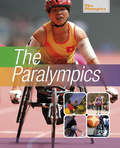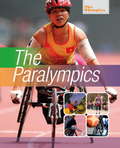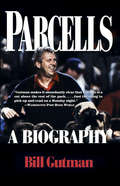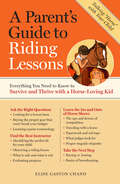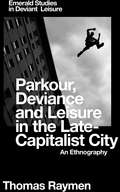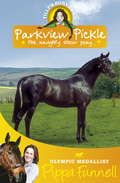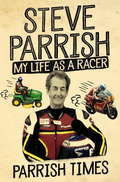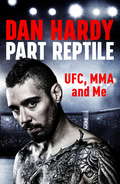- Table View
- List View
Paralympic Tennis - Wheelchair (UEB contracted)
by RnibOn this page, there are three images: a player about to return a high ball, a player returning a service and a small image of a player serving a ball to his opponent. All of the players are wheelchair users. Each image has a dashed line image border. There is a locator dot shown, which will be at the top left of the page when the image is the correct way up. Player about to return a high ball (left). This image fills the left side of the page. It shows a tennis player, seen from the front, in her wheelchair. The player's head is turned to the right in the left centre of the image with her hair in a ponytail to the left. Only one of her eyes can be found. Down the page are her shoulders with one arm to the right extending up and to the right. She holds a tennis racquet in her hand and is about to hit the ball, which is to the left of the racquet. Her other arm goes down the page from her shoulders to her hand resting on the wheel of her chair, which is seen from the front with its wheels to the left and right. The player's body and legs are further down the page from her shoulders. She is wearing a grey sleeveless vest and red shorts. Player returning a service (top right). This image shows a player returning a ball that has been served to her. She is seen from the side so that only one of her eyes can be found. The player's head is in the top centre of the image, facing to the left. She is wearing a sun visor that sticks out from her forehead with a band around her head. Down the page, her arm can be found extending left to her hand holding a racquet. The ball has been hit by the racquet and is now in the top left corner of the image, travelling to the left. Down and right from the player's head are her shoulders, with her other arm stretched out to the right. Further down the page you can find her body, perched on the seat of the wheelchair with her one visible leg going left and down to her foot on the footrest. The large spoked, round wheel of the chair is to the right of her foot. Player serving the ball to his opponent (bottom right). There are two players shown in this image. They are both in wheelchairs and seen from the side at a much smaller scale than the other images. One player is in the bottom left of the image; he is facing to the right with his racquet held out to the right. In the bottom centre of the image you can find the vertical line of the tennis net seen from the side. The other player is in the bottom right of the image, facing to the left. He has just thrown the ball up in the air with his hand on the left. To the right he holds up his racquet, about to hit the ball. He has both legs amputated above the knee, although only one of them is visible.
Paralympic Tennis - Wheelchair (UEB uncontracted)
by RnibOn this page, there are three images: a player about to return a high ball, a player returning a service and a small image of a player serving a ball to his opponent. All of the players are wheelchair users. Each image has a dashed line image border. There is a locator dot shown, which will be at the top left of the page when the image is the correct way up. Player about to return a high ball (left). This image fills the left side of the page. It shows a tennis player, seen from the front, in her wheelchair. The player's head is turned to the right in the left centre of the image with her hair in a ponytail to the left. Only one of her eyes can be found. Down the page are her shoulders with one arm to the right extending up and to the right. She holds a tennis racquet in her hand and is about to hit the ball, which is to the left of the racquet. Her other arm goes down the page from her shoulders to her hand resting on the wheel of her chair, which is seen from the front with its wheels to the left and right. The player's body and legs are further down the page from her shoulders. She is wearing a grey sleeveless vest and red shorts. Player returning a service (top right). This image shows a player returning a ball that has been served to her. She is seen from the side so that only one of her eyes can be found. The player's head is in the top centre of the image, facing to the left. She is wearing a sun visor that sticks out from her forehead with a band around her head. Down the page, her arm can be found extending left to her hand holding a racquet. The ball has been hit by the racquet and is now in the top left corner of the image, travelling to the left. Down and right from the player's head are her shoulders, with her other arm stretched out to the right. Further down the page you can find her body, perched on the seat of the wheelchair with her one visible leg going left and down to her foot on the footrest. The large spoked, round wheel of the chair is to the right of her foot. Player serving the ball to his opponent (bottom right). There are two players shown in this image. They are both in wheelchairs and seen from the side at a much smaller scale than the other images. One player is in the bottom left of the image; he is facing to the right with his racquet held out to the right. In the bottom centre of the image you can find the vertical line of the tennis net seen from the side. The other player is in the bottom right of the image, facing to the left. He has just thrown the ball up in the air with his hand on the left. To the right he holds up his racquet, about to hit the ball. He has both legs amputated above the knee, although only one of them is visible.
Paralympic track cycling (Large Print)
This page has two images on it: a cyclist with a prosthetic leg and a rider cycling with one leg. Each image has a dashed line image border. There is a locator dot shown, which will be at the top left of the page when the image is the correct way up. Track cyclist with a prosthetic leg - The image on the left of the page shows a track cyclist seen from the side and facing right. The rider's head is in the top centre of the image. Only one of his eyes can be found. He is wearing a racing helmet that tapers to a point at the left to reduce wind resistance. His body curves left and then right and down to his prosthesis, which continues down the page to where it is attached to the pedal of the bike. His other leg has not been shown as it mostly hidden behind the cycle. The bike fills the bottom half of the image. There is a wheel at the left, then the chain, the chainwheel and pedal to the right. The front wheel is at the bottom right of the image. The bike's carbon fibre frame is in the area between the wheels. It is filled with a light texture.Rider cycling with one leg - This image is on the right of the page. It shows a rider and bike from the front. The rider's head is at the top of the image wearing a helmet with ventilation slots. His neck cannot be found as he is leaning forward. His shoulders are to either side with his arms leading down the page to his hands holding the bike's handlebars. Down from the rider's hand on the left is his leg, leading down to the pedal. Down from the hand on the right is the stump of the rider's other leg, which has been amputated at the thigh. Further down and left is the fork and front wheel of the bike. The tyre on the wheel is very narrow to reduce rolling resistance.
Paralympic track cycling (UEB Contracted)
This page has two images on it: a cyclist with a prosthetic leg and a rider cycling with one leg. Each image has a dashed line image border. There is a locator dot shown, which will be at the top left of the page when the image is the correct way up. Track cyclist with a prosthetic leg - The image on the left of the page shows a track cyclist seen from the side and facing right. The rider's head is in the top centre of the image. Only one of his eyes can be found. He is wearing a racing helmet that tapers to a point at the left to reduce wind resistance. His body curves left and then right and down to his prosthesis, which continues down the page to where it is attached to the pedal of the bike. His other leg has not been shown as it mostly hidden behind the cycle. The bike fills the bottom half of the image. There is a wheel at the left, then the chain, the chainwheel and pedal to the right. The front wheel is at the bottom right of the image. The bike's carbon fibre frame is in the area between the wheels. It is filled with a light texture.Rider cycling with one leg - This image is on the right of the page. It shows a rider and bike from the front. The rider's head is at the top of the image wearing a helmet with ventilation slots. His neck cannot be found as he is leaning forward. His shoulders are to either side with his arms leading down the page to his hands holding the bike's handlebars. Down from the rider's hand on the left is his leg, leading down to the pedal. Down from the hand on the right is the stump of the rider's other leg, which has been amputated at the thigh. Further down and left is the fork and front wheel of the bike. The tyre on the wheel is very narrow to reduce rolling resistance.
Paralympic track cycling (UEB Uncontracted)
This page has two images on it: a cyclist with a prosthetic leg and a rider cycling with one leg. Each image has a dashed line image border. There is a locator dot shown, which will be at the top left of the page when the image is the correct way up. Track cyclist with a prosthetic leg - The image on the left of the page shows a track cyclist seen from the side and facing right. The rider's head is in the top centre of the image. Only one of his eyes can be found. He is wearing a racing helmet that tapers to a point at the left to reduce wind resistance. His body curves left and then right and down to his prosthesis, which continues down the page to where it is attached to the pedal of the bike. His other leg has not been shown as it mostly hidden behind the cycle. The bike fills the bottom half of the image. There is a wheel at the left, then the chain, the chainwheel and pedal to the right. The front wheel is at the bottom right of the image. The bike's carbon fibre frame is in the area between the wheels. It is filled with a light texture.Rider cycling with one leg - This image is on the right of the page. It shows a rider and bike from the front. The rider's head is at the top of the image wearing a helmet with ventilation slots. His neck cannot be found as he is leaning forward. His shoulders are to either side with his arms leading down the page to his hands holding the bike's handlebars. Down from the rider's hand on the left is his leg, leading down to the pedal. Down from the hand on the right is the stump of the rider's other leg, which has been amputated at the thigh. Further down and left is the fork and front wheel of the bike. The tyre on the wheel is very narrow to reduce rolling resistance.
The Paralympics: The Paralympics Library Ebook (The Olympics #1)
by Nick HunterThis book looks at the Paralympics, from the athletes and the sports to the stadiums and the spectators!
The Paralympics: The Paralympics Library Ebook (The Olympics #12)
by Nick HunterThis book looks at the Paralympics, from the athletes and the sports to the stadiums and the spectators!
Parcells: A Biography
by Bill GutmanIn January 2000, shortly after the New York Jets ended their '99 season, their coach, Bill Parcells, retired. By then he had won 149 games, lost 106, tied one, led three major pro football teams out of serious slumps, and taken two of them to the Super Bowl. He had made football history; he'd become the NFL's miracle man. Both intimidating and disarming, with a tongue like a whip and the temperament of a tyrant, Bill Parcells joined the failing New York Giants in 1983. By 1990 he'd twice taken the team to the Super Bowl. Three years later he took in tow the downtrodden New England Patriots, whom he propelled to the Super Bowl in his fourth season. He returned to New York in 1997, this time to rally the Jets. In two seasons the team with a lamentable 1-15 record had won a division title and missed the Super Bowl by only a game. In 1999, beleaguered by injuries to key players, the Jets nose-dived, losing six of its first seven games, but Parcells still managed to salvage the season with an 8-8 finish. While this biography candidly assesses the career of a consummate coach, it also examines the driving force that took hold of Parcells early and never let him go. Call it ambition, a dream, bulldog spirit, or perfectionism, it made him one of the winningest coaches in NFL history.
Parenting in Youth Sport: From Research to Practice
by Nicholas L. Holt Camilla J. KnightBeing the parent of a young athlete is a complex and challenging endeavour. Parents play a pivotal role in the development of young people in reaching their full potential in sport – indeed, the psychological and practical support of parents can be as vital to young athletes as the appropriate coaching and facilities. This book brings together current research into the impact of parenting in youth sport and examines the relationships between athletes, coaches and parents, whilst also discussing topics such as parenting styles, behaviour at competition and talent development. This book not only outlines the theories of parenting in youth sport, but also utilises research and examples from several countries, including the UK, US, Canada, and Australia. It has a research-to-practice theme and includes numerous suggestions for research projects (and getting research published). Parenting in Youth Sport is an essential text for students, lecturers and practitioners with an interest in youth sport, sport psychology or sport development.
Parenting in Youth Sport: From Research to Practice
by Nicholas L. Holt Camilla J. KnightBeing the parent of a young athlete is a complex and challenging endeavour. Parents play a pivotal role in the development of young people in reaching their full potential in sport – indeed, the psychological and practical support of parents can be as vital to young athletes as the appropriate coaching and facilities. This book brings together current research into the impact of parenting in youth sport and examines the relationships between athletes, coaches and parents, whilst also discussing topics such as parenting styles, behaviour at competition and talent development. This book not only outlines the theories of parenting in youth sport, but also utilises research and examples from several countries, including the UK, US, Canada, and Australia. It has a research-to-practice theme and includes numerous suggestions for research projects (and getting research published). Parenting in Youth Sport is an essential text for students, lecturers and practitioners with an interest in youth sport, sport psychology or sport development.
A Parent's Guide to Riding Lessons: Everything You Need to Know to Survive and Thrive with a Horse-Loving Kid
by Elise Gaston ChandIf you don&’t know the difference between a bridle and a saddle but your child dreams of riding horses, this informative guide will answer all of your most pressing questions. Elise Gaston Chand provides informed and sensible tips on finding qualified instructors, the cost of lessons, safety concerns, and much more. Learn what to watch for as your child&’s riding progresses, confidently steer your child toward rewarding competition experiences, and take pride in all of your child&’s riding achievements.
Parkour, Deviance and Leisure in the Late-Capitalist City: An Ethnography (Emerald Studies in Deviant Leisure)
by Thomas RaymenTaking us on an ethnographic journey into the spatially transgressive practice of parkour and freerunning, Parkour, Deviance and Leisure in the Late-Capitalist City: An Ethnography attempts to explain and untangle some of the contradictions that surround this popular lifestyle sport and its exclusion from our hyper-regulated cities. While the existing criminological wisdom suggests that these practices are a form of politicised resistance, this book positions parkour and freerunning as hyper-conformist to the underlying values of consumer capitalism and explains how late-capitalism has created a contradiction for itself in which it must stoke desire for these lifestyle practices whilst also excluding their free practice from central urban spaces. Drawing on the emergent deviant leisure perspective, this book takes us into the life-worlds of young people who are attempting to navigate the challenges and anxieties of early adulthood. For the young people in this study, consumer capitalism's commodification of rebellious iconography offered unique identities of 'cool individualism' and opportunities for flexibilised employment; while the post-industrial 'creative city' attempted to harness parkour's practice, prohibitively if necessary, into approved spatial contexts under the buzzwords of 'culture' and 'creativity'. This book offers a vital contribution to the criminological literature on spatial transgression, and in doing so, engages in a critical reappraisal of the evolution of the relationships between work, leisure, identity and urban space in consumer capitalism.
Parkour, Deviance and Leisure in the Late-Capitalist City: An Ethnography (Emerald Studies in Deviant Leisure)
by Thomas RaymenTaking us on an ethnographic journey into the spatially transgressive practice of parkour and freerunning, Parkour, Deviance and Leisure in the Late-Capitalist City: An Ethnography attempts to explain and untangle some of the contradictions that surround this popular lifestyle sport and its exclusion from our hyper-regulated cities. While the existing criminological wisdom suggests that these practices are a form of politicised resistance, this book positions parkour and freerunning as hyper-conformist to the underlying values of consumer capitalism and explains how late-capitalism has created a contradiction for itself in which it must stoke desire for these lifestyle practices whilst also excluding their free practice from central urban spaces. Drawing on the emergent deviant leisure perspective, this book takes us into the life-worlds of young people who are attempting to navigate the challenges and anxieties of early adulthood. For the young people in this study, consumer capitalism's commodification of rebellious iconography offered unique identities of 'cool individualism' and opportunities for flexibilised employment; while the post-industrial 'creative city' attempted to harness parkour's practice, prohibitively if necessary, into approved spatial contexts under the buzzwords of 'culture' and 'creativity'. This book offers a vital contribution to the criminological literature on spatial transgression, and in doing so, engages in a critical reappraisal of the evolution of the relationships between work, leisure, identity and urban space in consumer capitalism.
parkrun: An Organised Running Revolution
by David HindleyThis is the first book to take an in-depth look at parkrun - the free, weekly, timed 5km run on a Saturday morning - and to examine why its participants love it so much and why it has been such an astonishing success. Author David Hindley – a self-described ‘middle of the pack’ parkrunner – draws on new research, including interviews with other runners, volunteers and organisers, to shine a light on the unique combination of ingredients in parkrun’s magic formula. Tracing the development of parkrun from its first event in the UK in 2004 to the global network of today, he takes a close look at themes like inclusion, volunteering, community, green space, health and well-being, and unpacks the mantra of ‘it’s a run not a race’ that has come to define the spirit of parkrun for so many of its participants. Part sporting event, part social movement, and part public health intervention, parkrun perhaps offers a model for sustainable public participation in other areas of social life. This book is compulsory behind-the-scenes reading for all parkrunners and parkrun volunteers, and anybody working in sport development, events, recreation, public health, volunteering or community organising.
parkrun: An Organised Running Revolution
by David HindleyThis is the first book to take an in-depth look at parkrun - the free, weekly, timed 5km run on a Saturday morning - and to examine why its participants love it so much and why it has been such an astonishing success. Author David Hindley – a self-described ‘middle of the pack’ parkrunner – draws on new research, including interviews with other runners, volunteers and organisers, to shine a light on the unique combination of ingredients in parkrun’s magic formula. Tracing the development of parkrun from its first event in the UK in 2004 to the global network of today, he takes a close look at themes like inclusion, volunteering, community, green space, health and well-being, and unpacks the mantra of ‘it’s a run not a race’ that has come to define the spirit of parkrun for so many of its participants. Part sporting event, part social movement, and part public health intervention, parkrun perhaps offers a model for sustainable public participation in other areas of social life. This book is compulsory behind-the-scenes reading for all parkrunners and parkrun volunteers, and anybody working in sport development, events, recreation, public health, volunteering or community organising.
Parkview Pickle the Show Pony: Book 9 (Tilly's Pony Tails #9)
by Pippa FunnellMeet Tilly Redbrow, who doesn't just love horses - she lives, breathes and dreams them too! When Parkview Pickle arrives at Silver Shoe Farm it's clear to Tilly that something isn't right. She may be a show pony, but she's restless, fussy and just a little bit overweight. Can Tilly persuade Pickle's owner to let her help?From Pony Club to riding for the British team, and for every girl who has ever longed for a pony of her own, these delightful, warm and engaging stories are packed with Pippa Funnell's expert advice on everything you ever wanted to know about horses.
Parkview Pickle the Show Pony (Pippa's Pony Tales #9)
by Pippa FunnellTilly dreams of having a pony of her own. One that only she can ride to stardom. Will her wishes come true when she joins Silver Shoe Farm Stables?Tilly and Magic Spirit are happy at Silver Shoe Farm. But when the dainty and elegant show pony Parkview Pickle arrives, Tilly knows straightaway that something is wrong. She wants to help, but she's not sure that Pickle's owner will let her. Collect all 18 titles in this series of irresistible, uplifting and heartwarming pony adventures. Printed in a dyslexia friendly font and packed with up to date tips from three times Olympic Medallist, Pippa Funnell, as well as a helpful glossary and black and white illustrations on every spread.
Parrish Times: My Life as a Racer
by Steve ParrishChampion motorcyclist and truck racer, television presenter, practical joker or just plain survivor - Steve Parrish has been called them all. Parrish Times tracks his amazing journey over the last four decades, through a rollercoaster ride of emotions in surely the most dangerous and exhilarating sporting arena there is.In the 1970s Steve was competing for the world motorcycle championship with legendary team mate Barry Sheene on a Suzuki. After retiring in 1986, Steve managed a successful Yamaha factory team to three British Superbike Championship titles and started a truck-racing career, becoming the most successful truck racer ever. He also proved to be a natural commentator, first for BBC radio, then transferring to television with Sky, ITV and Eurosport. Against this backdrop are Steve's notorious pranks: posing as a medical doctor to allow John Hopkins to fly from Japan to the Australian GP; impersonating Barry Sheene in a qualifying session; owning a fire engine, a hearse, and an ambulance - parking it on double yellow lines with the doors open in visits to his local bank.
Part Reptile: UFC, MMA and Me
by Dan HardyFor fans of Ronda Rousey's My Fight Your Fight and John Kavanagh's Win or Learn comes the first book from UFC fighter and now analyst Dan Hardy, who lifts the lid on his own career and writes with insight and eloquence on all things MMA and UFC, the brutal and ever-evolving sport that launched such superstars as Conor McGregor, Michael Bisping, Georges St-Pierre, Nate Diaz and Amanda Nunes.Dan Hardy's first book is much more than a straightforward MMA autobiography. Taking the key fights from his career, Hardy explores the sport with the unparalleled insight that has made him the best analyst working today.From training in China with Shaolin monks, to how MMA helped him channel his rage, to psychedelics and the ceremony in Peru that changed his life, to tapping into his 'reptilian brain' and the psychological warfare of UFC, to his epic title fight with Georges St-Pierre.Hardy also speaks eloquently of the heart condition that forced him to stop fighting, the road to recovery, and the evolution of a sport that flies in the face of mainstream disapproval to entertain and thrill millions of obsessives around the globe.
Partial Knee Arthroplasty E-Book: Techniques and Optimal Outcomes - Expert Consult
by Keith R. Berend Fred CushnerPartial Knee Arthroplasty helps you optimize outcomes using the latest best-practice techniques for this increasingly popular procedure. Drs. Keith R. Berend and Fred D. Cushner discuss recent advances and hot topics—such as custom guided implants, biologics, failed PKA, TKA conversion, and more—along with the challenges of choosing the right technique for each patient. The clear focus on surgical techniques, bulleted key points, and procedural videos online at www.expertconsult.com make this comprehensive, practical reference ideal for learning how to achieve the best results.Access the fully searchable text online at www.expertconsult.com, along with a gallery of procedural videos. Apply recent advances and best-practice techniques effectively thanks to global perspectives and analyses of surgical approaches. Improve patient outcomes with clear, direct, and focused coverage of surgical techniques. Find information quickly and easily with a bulleted format for convenient "at-a-glance" reference to key details and ease of use in a mobile environment.
Participation in Sport: International Policy Perspectives
by Matthew NicholsonAlthough there is growing interest from governments in participation levels in sport, the extent to which governments actively promote ‘sport for all’ and their motives for doing so vary greatly. This is the first book to examine the sport participation policies of national governments across the world and to offer a comparative analysis of the motives for, and successes and failures of those policies. Organized around a series of sixteen national case studies, including the UK, the US, Australia, China and India, the book enables students and practitioners to compare and contrast the development, implementation and impact of sport participation policies throughout the world. An introductory chapter provides a framework for understanding and interpreting those case studies and each chapter then addresses the following key themes: national structures for sport national sporting cultures participation levels in organized sport the nature and extent of government intervention implementation of governmental policy the impact of government policy. With contributions from many of the world’s leading experts on sport policy and sport development, this book is essential reading for anybody with an interest in the role of governments in relation to supporting and regulating their citizens’ involvement in sport.
Participation in Sport: International Policy Perspectives
by Matthew Nicholson Russell Hoye Barrie HoulihanAlthough there is growing interest from governments in participation levels in sport, the extent to which governments actively promote ‘sport for all’ and their motives for doing so vary greatly. This is the first book to examine the sport participation policies of national governments across the world and to offer a comparative analysis of the motives for, and successes and failures of those policies. Organized around a series of sixteen national case studies, including the UK, the US, Australia, China and India, the book enables students and practitioners to compare and contrast the development, implementation and impact of sport participation policies throughout the world. An introductory chapter provides a framework for understanding and interpreting those case studies and each chapter then addresses the following key themes: national structures for sport national sporting cultures participation levels in organized sport the nature and extent of government intervention implementation of governmental policy the impact of government policy. With contributions from many of the world’s leading experts on sport policy and sport development, this book is essential reading for anybody with an interest in the role of governments in relation to supporting and regulating their citizens’ involvement in sport.
Participatory Research in Sport and Physical Activity (Qualitative Research in Sport and Physical Activity)
by Robyn Smith Kyle A. Rich Audrey R. GilesThis is the first book to focus on participatory research in the context of sport and physical activity. It explores the transformative potential of participatory research methods and provides an introduction to the practicalities of doing participatory research in sport and physical activity.The book is structured around phases of the research process, covering research design, data collection, data analysis, and knowledge mobilization and translation. Chapters cover research design topics such as building research partnerships, reflexivity and ethical issues; methods such as social photo-elicitation, go-along interviews, and biographical mapping; analytical approaches such as collective memory work and collaborative analysis; and knowledge mobilization and translation topics such as podcasting, digital tools, and peer review. Every chapter includes a review of key developments, a guide to how that approach can be employed, an example from the author’s own work, and critical reflections on how that approach can shape future research and have an impact on public discourse.This book is an invaluable resource for students and researchers working in sport studies, the sociology of sport, sport and exercise psychology, sport management and policy, and human movement and health studies more broadly. It will be particularly useful for those interested in diverse and inclusive approaches to qualitative research methodologies.
Participatory Research in Sport and Physical Activity (Qualitative Research in Sport and Physical Activity)
by Robyn Smith Kyle A. Rich Audrey R. GilesThis is the first book to focus on participatory research in the context of sport and physical activity. It explores the transformative potential of participatory research methods and provides an introduction to the practicalities of doing participatory research in sport and physical activity.The book is structured around phases of the research process, covering research design, data collection, data analysis, and knowledge mobilization and translation. Chapters cover research design topics such as building research partnerships, reflexivity and ethical issues; methods such as social photo-elicitation, go-along interviews, and biographical mapping; analytical approaches such as collective memory work and collaborative analysis; and knowledge mobilization and translation topics such as podcasting, digital tools, and peer review. Every chapter includes a review of key developments, a guide to how that approach can be employed, an example from the author’s own work, and critical reflections on how that approach can shape future research and have an impact on public discourse.This book is an invaluable resource for students and researchers working in sport studies, the sociology of sport, sport and exercise psychology, sport management and policy, and human movement and health studies more broadly. It will be particularly useful for those interested in diverse and inclusive approaches to qualitative research methodologies.
Partizipation von Schülerinnen und Schülern bei der Leistungsbeurteilung: Eine qualitative Studie aus der Perspektive von Sportlehrkräften (Bildung und Sport #36)
by Lorena MenzePartizipation von Kindern und Jugendlichen kann zu ihrer Persönlichkeitsentwicklung beitragen, die eine zentrale Aufgabe der Schule ist. Demgegenüber obliegt es ihr aber auch, Selektionsentscheidungen über die Zukunft der Schülerinnen und Schüler zu treffen. Diese Ambivalenz manifestiert sich ganz konkret in Form der Leistungsbeurteilung. Hier sehen sich Lehrkräfte mit der Herausforderung zwischen mitbestimmter Beteiligung der Schülerinnern und Schüler und fremdbestimmter Bewertung ihrer Leistungen konfrontiert.In diesem Buch werden Möglichkeiten und Motive zur Partizipation von Schüler*innen bei der Leistungsbeurteilung aus der Perspektive von Sportlehrkräften dargestellt. Dabei wird ein theoretisches Konstrukt der Partizipation von Schüler*innen umfassend dargelegt, gefolgt von der Betrachtung der Leistungsbeurteilung im (Sport-)Unterricht. Auf Basis von qualitativen Interviews mit Sportlehrkräften werden erstens die Situationstypen Leistungsvereinbarung, -erbringung, -feststellung, -bewertung ermittelt, die wiederum weitere Subkategorien beinhalten. Zweitens werden sechs übergeordnete Motive der Lehrkräfte als handlungsleitend für die Implementation von Partizipation bei verschiedenen Phasen der Leistungsbeurteilung herausgearbeitet. Als zentrales Ergebnis dieser Untersuchung zeigt sich, dass Partizipation bei der Leistungsbeurteilung durchaus umgesetzt wird, hier allerdings die Tragweite des jeweiligen Entscheidungsspielraums variiert und sich dahingehend auch die Motive zwischen einem eher instrumentalisierten und einem rechtebasierten Einsatz von Partizipation unterscheiden.

